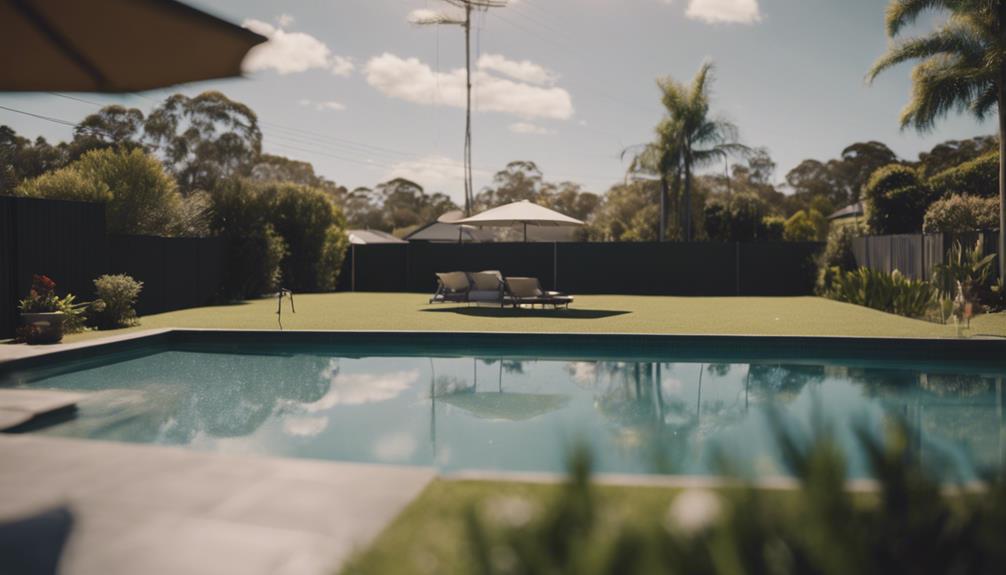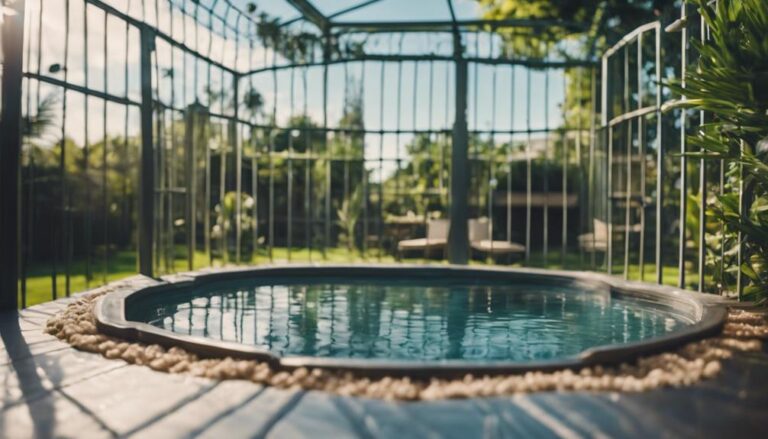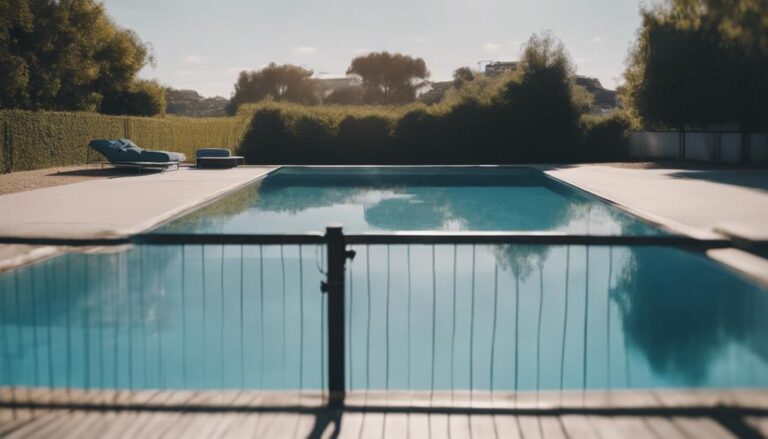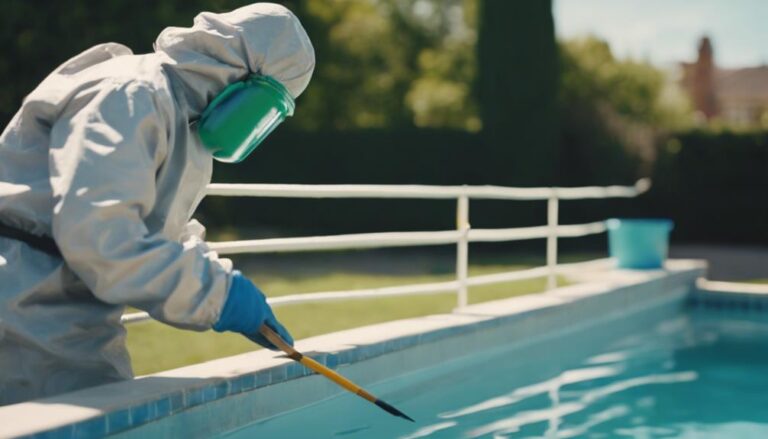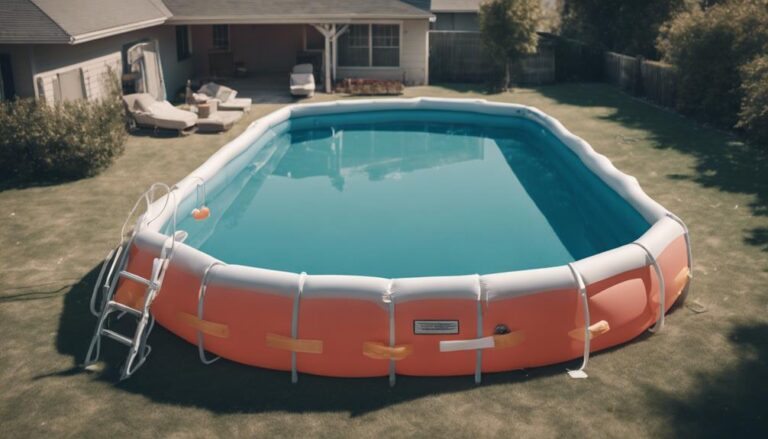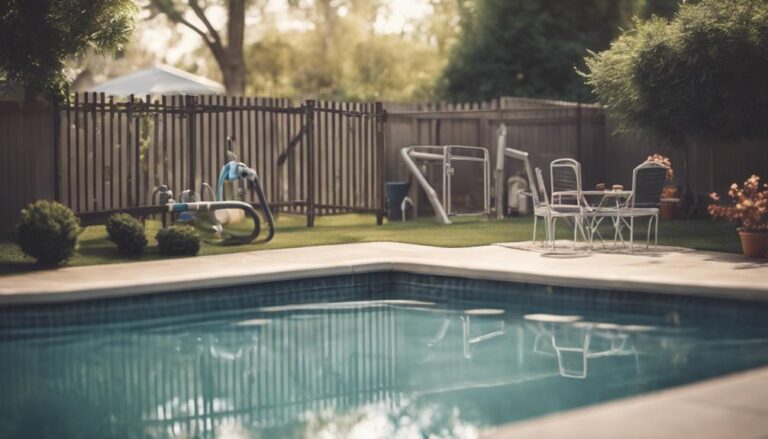How close can a pool be to a boundary fence in Queensland?
In Queensland, you must position your pool a minimum distance of 1000mm (1 metre) from the boundary fence to comply with safety regulations. This spacing ensures a clear separation between your pool and the fence, which may also serve as an approved safety barrier if it meets certain criteria, such as specific height and non-climbable zones.
It is crucial to follow these guidelines to ensure the safety of pool users and avoid legal issues. Moreover, it is important to make sure there are no objects that can be climbed within 900mm of the fence to remain compliant and enhance safety.
By understanding and adhering to these regulations, you will not only guarantee the safety and enjoyment of your pool area but also discover more ways to enhance your poolside experience.
Understanding Pool Placement
To comply with regulations, it is necessary to position your pool a minimum of 1000mm from the boundary fence. As a pool owner in Queensland, understanding the specifics of pool placement in relation to your boundary fence is crucial for adhering to Queensland's regulations. This distance creates a clear separation between your pool area and adjacent properties, significantly contributing to pool safety.
The boundary fence, which often serves as a garden or dividing fence, can act as an appropriate barrier for your pool. However, this does not remove the requirement for precise placement. Maintaining this minimum distance is vital not only for compliance but to improve the safety and privacy of your pool area. This gap allows for the addition of further pool barriers if necessary, enhancing the safety perimeter around your aquatic space.
Following these guidelines ensures compliance with the legal requirements set by Queensland regulations. It demonstrates a commitment to pool safety, safeguarding both your family and your neighbours. Correct pool placement is a crucial step in ensuring your pool area is safe, compliant, and enjoyable for all.
Pool Fence Requirements
In Queensland, the law requires your swimming pool to be at least 1000mm away from the boundary fence, ensuring that the fence can double as part of the safety barrier if it meets specific standards.
It's essential that you are aware of these legal distance regulations and safety barrier standards to comply with safety and legal requirements. By understanding and following these regulations, you guarantee the safety of pool users and prevent possible legal problems.
Legal Distance Regulations
Understanding the legal distance regulations is paramount for pool owners in Queensland, as pools must be positioned at least 1000mm away from boundary fences to comply with safety standards. This minimum distance guarantees the effectiveness of the pool barrier, maintaining a non-climbable zone and reducing risks associated with unsupervised access.
Notably, the boundary fence itself can serve as part of the pool barrier if it meets certain height and non-climbable zone requirements. Utilising the boundary fence as a component of the pool barrier is a common practice in Queensland, streamlining compliance and enhancing safety.
Adherence to these regulations is vital for pool owners, as it directly impacts the safety and legal compliance of their pool area.
Safety Barrier Standards
Having addressed the legal requirements for the positioning of pools, we will now examine the specific safety barrier standards that are relevant to pool fences in Queensland.
The perimeter fence can act as a pool barrier if it meets strict safety criteria. In Queensland, regulations for pool safety state that pool fences, including perimeter fences used as part of the pool barrier, must be located at least 1000mm away from the pool to prevent climbing and unauthorised access.
These fences must meet specific height and non-climbable zone regulations to be considered safe. Compliance with these safety standards is crucial, not only for legal reasons but also to ensure the safety of all pool users by significantly reducing the risk of unauthorised or unsupervised access to the pool area.
Non-Climbable Zones Explained
To ensure the safety of your swimming pool area, it's crucial to understand that in Queensland, non-climbable zones surrounding pool fences must be at least 900mm wide on the inside of the fence. This requirement starts at the top of the fence and extends downwards to prevent climbing and reduce the risk of accidental falls into the pool.
If it's not possible to create a non-climbable zone on the outside of the fence, the regulations stipulate that the fence must be a minimum height of 1800mm, with a 900mm non-climbable zone on the inside.
To comply with these rules, homeowners can use flat polycarbonate sheeting or install vertical palings as effective deterrents against climbing. However, compliance involves more than just installing the right barriers. Regular maintenance, especially concerning vegetation and garden beds near the pool fence, is essential.
Without proper upkeep, plants and garden features could unintentionally offer footholds or leverage for climbing. Following Queensland regulations requires regular inspection and maintenance of any vegetation or garden beds near the boundary fence to ensure they do not encroach on the non-climbable zone.
Dealing With Climbable Objects
To ensure pool safety, it is crucial to address the presence of objects that can be climbed near pool fences. This includes BBQs, outdoor furniture, and vegetation. Trees, shrubs, and potted plants could inadvertently help someone climb over the pool fence, potentially compromising its effectiveness. Garden features, edging, and branches hanging over the fence also pose risks that should not be overlooked.
To effectively prevent climbing attempts, it is important to ensure that no objects within 900mm of the pool fence offer handholds or footholds. This includes keeping the ground clear of raised garden beds and similar features that could aid climbing. Installing barriers like flat polycarbonate sheeting or vertical palings can enhance pool fence strength by eliminating gaps and surfaces that could be used for climbing.
Vegetation plays a significant role in pool safety. Trimming trees, shrubs, and relocating potted plants away from the pool fence are essential steps to remove potential aids for climbing. By following these guidelines, you can improve the security of your pool area, ensuring that pool fences effectively prevent unsupervised access.
Compliance and Maintenance Tips
After addressing the hazards presented by objects near pool fences that can be climbed, the next step is to concentrate on maintaining compliance and ensuring the safety of your pool through consistent maintenance and adherence to the regulations in Queensland. Pools in QLD are required to be situated at least 1000mm away from the boundary fence to comply with regulations. This rule ensures a non-climbable zone is preserved, thereby diminishing the risk of accidents.
Utilising a boundary fence as a pool barrier is a widely accepted practice, as long as it adheres to the height and non-climbable zone criteria established by Queensland regulations. Engaging in regular maintenance to meet these criteria is essential. The responsibility for the upkeep of a dividing fence used as a pool barrier is shared between you and your neighbours. This joint effort aids in preventing the deterioration that could undermine safety.
Complying with these specific regulations not only guarantees the safety of pool users but also confirms compliance with legal standards in Queensland. Conducting regular inspections for wear and tear, ensuring the non-climbable zone remains free of objects that could assist in climbing, and maintaining the required height and strength of the fence are crucial in keeping your pool area secure and compliant.
Understanding State Regulations
Understanding the specifics of Queensland's pool fence regulations is essential for ensuring your pool area is both safe and compliant with local laws. This involves more than just maintaining the water quality or the pool's physical condition; it also includes its positioning within your garden, especially its proximity to the boundary fence.
Here are three critical points to understand:
- Minimum Distance Requirement: It's mandatory for pools to be situated at least 1000mm away from the boundary fence. This distance is vital for safety and adherence to Queensland's strict standards.
- Boundary as Barrier: A garden or division fence can serve as part of your pool's safety barrier, provided it meets the required specifications. This option allows you to use your garden space efficiently while complying with regulations.
- Adherence to Regulations: Compliance with these rules is crucial for ensuring that your pool area isn't only enjoyable but also secure. Meeting the minimum distance requirement is fundamental for passing safety inspections.
Understanding and implementing these regulations will aid in maintaining a pool area that's both enjoyable and safe, aligning with Queensland's safety standards.
Frequently Asked Questions
How close to a fence can you build a pool?
You can build a pool as close as 1000mm to a boundary fence in Queensland. This distance ensures your pool's safety and complies with regulations, even if the fence doubles as a pool barrier.
What is the Fence Rule in Queensland?
In Queensland, your pool must be at least 1000mm from the boundary fence, but the fence can double as a pool barrier if it meets safety standards. It's vital to know these rules for compliance.
How much space do you need around a pool in Australia?
In Australia, you'll need to ensure there's a minimum of 1000mm space around your pool from any boundary fence. It's essential for safety and to comply with local regulations, so always check specific state rules.
What is the fine for a pool fence in Queensland?
You could be fined up to £26,690 as an individual or £133,450 for corporations if your pool fence doesn't meet the requirements in Queensland. Regular inspections and ensuring you meet the standards can help you prevent these high penalties.
